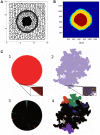Cellular potts modeling of tumor growth, tumor invasion, and tumor evolution
- PMID: 23596570
- PMCID: PMC3627127
- DOI: 10.3389/fonc.2013.00087
Cellular potts modeling of tumor growth, tumor invasion, and tumor evolution
Abstract
Despite a growing wealth of available molecular data, the growth of tumors, invasion of tumors into healthy tissue, and response of tumors to therapies are still poorly understood. Although genetic mutations are in general the first step in the development of a cancer, for the mutated cell to persist in a tissue, it must compete against the other, healthy or diseased cells, for example by becoming more motile, adhesive, or multiplying faster. Thus, the cellular phenotype determines the success of a cancer cell in competition with its neighbors, irrespective of the genetic mutations or physiological alterations that gave rise to the altered phenotype. What phenotypes can make a cell "successful" in an environment of healthy and cancerous cells, and how? A widely used tool for getting more insight into that question is cell-based modeling. Cell-based models constitute a class of computational, agent-based models that mimic biophysical and molecular interactions between cells. One of the most widely used cell-based modeling formalisms is the cellular Potts model (CPM), a lattice-based, multi particle cell-based modeling approach. The CPM has become a popular and accessible method for modeling mechanisms of multicellular processes including cell sorting, gastrulation, or angiogenesis. The CPM accounts for biophysical cellular properties, including cell proliferation, cell motility, and cell adhesion, which play a key role in cancer. Multiscale models are constructed by extending the agents with intracellular processes including metabolism, growth, and signaling. Here we review the use of the CPM for modeling tumor growth, tumor invasion, and tumor progression. We argue that the accessibility and flexibility of the CPM, and its accurate, yet coarse-grained and computationally efficient representation of cell and tissue biophysics, make the CPM the method of choice for modeling cellular processes in tumor development.
Keywords: cell-based modeling; cellular Potts model; evolutionary tumor model; multiscale modeling; tumor growth model; tumor invasion model; tumor metastasis model.
Figures



Similar articles
-
Multiscale Model of Colorectal Cancer Using the Cellular Potts Framework.Cancer Inform. 2015 Oct 4;14(Suppl 4):83-93. doi: 10.4137/CIN.S19332. eCollection 2015. Cancer Inform. 2015. PMID: 26461973 Free PMC article.
-
The effects of cell compressibility, motility and contact inhibition on the growth of tumor cell clusters using the Cellular Potts Model.J Theor Biol. 2014 Feb 21;343:79-91. doi: 10.1016/j.jtbi.2013.10.008. Epub 2013 Nov 6. J Theor Biol. 2014. PMID: 24211749 Free PMC article.
-
Surrogate modeling of Cellular-Potts Agent-Based Models as a segmentation task using the U-Net neural network architecture.ArXiv [Preprint]. 2025 May 5:arXiv:2505.00316v2. ArXiv. 2025. PMID: 40386573 Free PMC article. Preprint.
-
The matrix environmental and cell mechanical properties regulate cell migration and contribute to the invasive phenotype of cancer cells.Rep Prog Phys. 2019 Jun;82(6):064602. doi: 10.1088/1361-6633/ab1628. Epub 2019 Apr 4. Rep Prog Phys. 2019. PMID: 30947151 Review.
-
Cellular Potts modeling of complex multicellular behaviors in tissue morphogenesis.Dev Growth Differ. 2017 Jun;59(5):329-339. doi: 10.1111/dgd.12358. Epub 2017 Jun 8. Dev Growth Differ. 2017. PMID: 28593653 Review.
Cited by
-
Multiscale Modeling of Spheroid Tumors: Effect of Nutrient Availability on Tumor Evolution.J Phys Chem B. 2023 Apr 27;127(16):3607-3615. doi: 10.1021/acs.jpcb.2c08114. Epub 2023 Apr 3. J Phys Chem B. 2023. PMID: 37011021 Free PMC article.
-
In vivo confinement promotes collective migration of neural crest cells.J Cell Biol. 2016 Jun 6;213(5):543-55. doi: 10.1083/jcb.201602083. Epub 2016 May 30. J Cell Biol. 2016. PMID: 27241911 Free PMC article.
-
Data-driven spatio-temporal modelling of glioblastoma.R Soc Open Sci. 2023 Mar 22;10(3):221444. doi: 10.1098/rsos.221444. eCollection 2023 Mar. R Soc Open Sci. 2023. PMID: 36968241 Free PMC article. Review.
-
CellularPotts.jl: simulating multiscale cellular models in Julia.Bioinformatics. 2024 Jan 2;40(1):btad773. doi: 10.1093/bioinformatics/btad773. Bioinformatics. 2024. PMID: 38134421 Free PMC article.
-
Biophysics involved in the process of tumor immune escape.iScience. 2022 Mar 19;25(4):104124. doi: 10.1016/j.isci.2022.104124. eCollection 2022 Apr 15. iScience. 2022. PMID: 35402878 Free PMC article. Review.
References
-
- Andasari V., Chaplain M. A. J. (2012). Intracellular modelling of cell-matrix adhesion during cancer cell invasion. Math. Model. Nat. Phenom. 7, 29–4810.1051/mmnp/20127103 - DOI
-
- Anderson A. R. A., Basanta D., Gerlee P., Rejniak K. A. (2011). “Evolution, regulation, and disruption of homeostasis, and its role in carcinogenesis,” in Multiscale Cancer Modeling, eds Deisboeck T. S., Stamatakos G. S. (Boca Raton: Taylor & Francis; ), 1–30
LinkOut - more resources
Full Text Sources
Other Literature Sources

